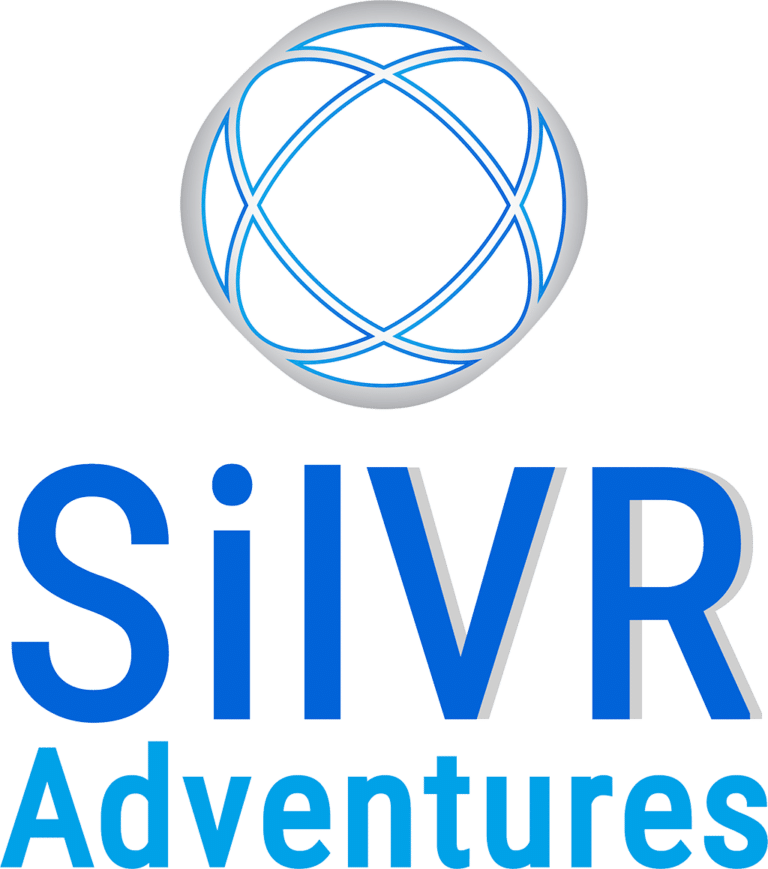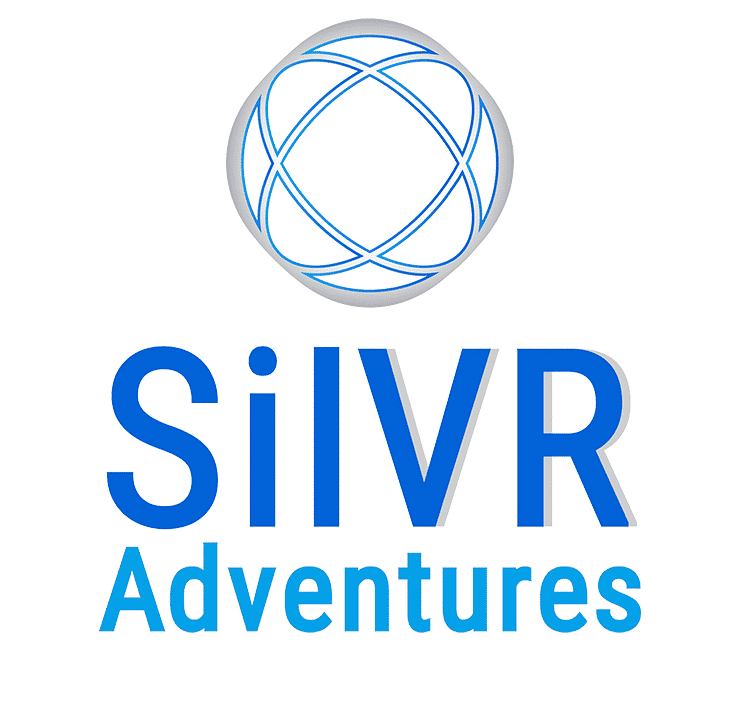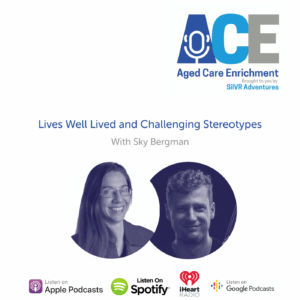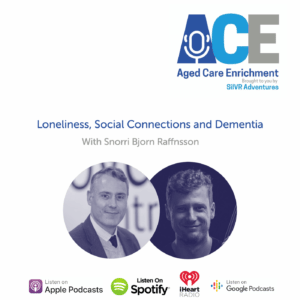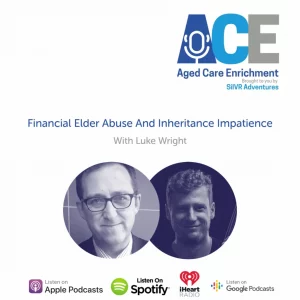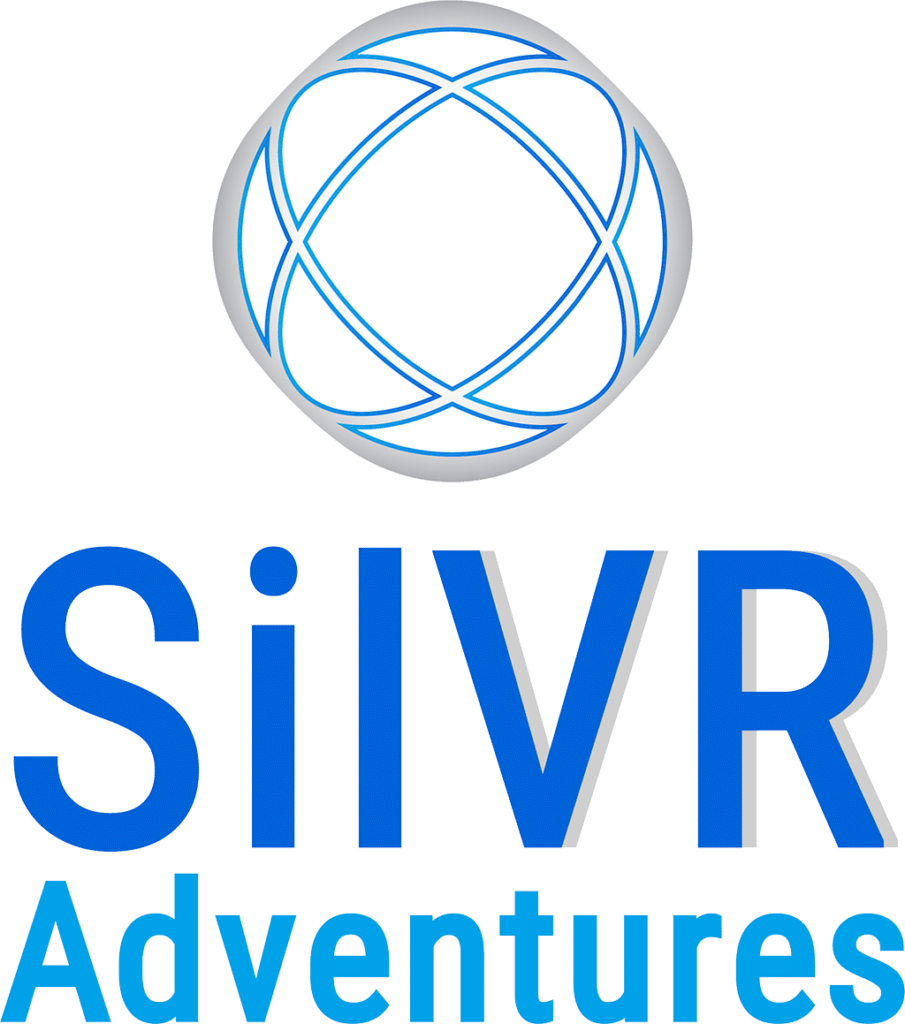Serial Entrepreneur, CEO and Founder of SilVR Adventures Colin Pudsey shares with us his journey into the aged care space. From a background in sales and marketing, to building and selling his first company, Colin now champions the benefits of virtual reality in aged care.
As he explains in this conversation, virtual reality is more than just a fun activity, it’s a tool that has both clinical and therapeutic uses, especially when used to target isolation and loneliness. But beyond that the possibility for improving the holistic well being of seniors is extraordinary.
Underpinning all of the benefits of virtual reality, and any tool, are the principles of it’s use and how it can be tailored for the interests and abilities of the individual. With this we can see that the way to make any treatment or activity more effective is to pair it with a thorough understanding of the individual’s identity.
Transcript
Ash de Neef: Well Colin, thanks for joining us on the show today.
Colin Pudsey: Wow. This is a bit different being in this chair.
Ash de Neef: Yeah, where the magic happens.
Colin Pudsey: Exactly. Exactly. Yeah. Thanks for having me, Ash.
Ash de Neef: No worries. And for those of us who don’t know you, can you give us a bit of a background to who you are, and why it might be interesting for you to be in that seat today?
Colin Pudsey: Sure. I am the founder and CEO of SilVR Adventures. SilVR Adventures provides a virtual reality based experience and communication solution specifically for seniors to help reduce feelings of isolation and loneliness. The business started life in the middle of 2019. Before that my background was in technology and solutions in a couple of different locations.
I used to reside in Singapore for a number of years. I had a business there. And before that, I guess quite a strong sales and business development background too, in the UK.
Ash de Neef: Great. I want to start with two words and maybe you can tell the story behind the words, but do the words Angel’s Gate mean anything to you?
Colin Pudsey: They do. So Angel’s gate was the Asia Pacific version of a Dragon’s Den, Shark Tank kind of TV show. Where entrepreneurs would go onto the show and you would pitch your business idea for investment. While I was living in Singapore with my first business that I started, I was selected to go on to this new show called Angel’s Gate and I pitched for investment and was one of six businesses throughout the series got invested in by the angels.
Ash de Neef: Fantastic. And was that business in the aged care space as well? Or was that something completely different?
Colin Pudsey: No, it was something completely different. So that business was environmentally friendly cleaning company and service company. And I was the first green cleaning company in Asia. Yeah. It was quite innovative and quite new at the time for a lot of people.
So a lot of awareness to build around the benefits and around the focus and the priorities. And that was a business that I had for seven years and then exit through sale. And my wife and I relocated to Australia.
Ash de Neef: Great. So moving to Australia and your company now, SilVR Adventures is based in the aged care industry.
What is it that drew you to the aged care industry?
Colin Pudsey: Good question. So my background is not at all clinical, nothing to do with aged care. Even the demographic with seniors I’ve never really worked with before. I was reading an article about how in 2018 was the first time in history that there were more people in the world that were over the age of 64 than there were under the age of five years old. And this was a trend that was going to continue. And the size of the elderly market was increasing.
And from a business point of view, that the value of that market was increasing for a number of reasons. There were lots of advancements, that were ongoing and, going to happen in the future, inevitably to lengthen your life. And medicines and initiatives and processes to improve the quality of your life. So I thought that this was a space that intrigued me purely first on the basis of the size of the market and be in a growing market.
With that, I started by Googling problems within the elderly care market. There were a whole host. There was no shortage of problems. Basically the one that really resonated with me was around the isolation problem problems with loneliness, people who don’t get visits while they’re in care, people who don’t have family or any form of communication like that.
Also that led into to mental health and issues like depression and anxiety and how that can be extrapolated with increased isolation and no social connection. I then started learn about things like the early onset of dementia, increased cost of care. There was just a whole host of problems that were entwined and overlaid. Like I said, that space really resonated with me. And then I started having a look at if there were potential solutions.
And my natural instinct would be to look at innovation and technology and possible solutions using new technologies. And that led to VR and virtual reality and looking for virtual reality to be part of that solution, to reduce those feelings of isolation and loneliness among seniors.
Ash de Neef: Great. And I imagine for some listeners, they’ve heard the word virtual reality before or VR, but they’re not really sure what it is. Can you give us a breakdown of what do you think when you think of VR?
Colin Pudsey: So virtual reality is really, it’s a simulated experience. That’s made to feel very real for the person who’s being immersed or interacting within that experience.
And they’re using specific equipment, like a virtual reality headset. So for us, with SilVR Adventures, virtual reality – It’s two areas of content, what we would call VR content.
And the first area is around 360 degree images and 360 degree videos. And the way that we would explain it, when we would go out to a group of seniors, it’s going to be like, when they look at a picture or it’s going to be like, when they look at a movie. But they’re going to be inside this picture, they’re going to be inside this movie and they can basically look all around them.
They can look behind them if they like. Those images, those videos, what we do as a business is that we build stories around those images and those videos, so that essentially we can develop a tour of a certain place. So that could be a tour of India, or China , or south America, but we would have that tour so that the person really feels like they’re in that location.
And they’re not only there on their own they’re in a group, that they’re with their friends or with their fellow residents. And they’re all at these places at the same time, seeing the same image and seeing the same video, but really being very immersed and feeling like they’re in that location. That’s the first area of of virtual reality content for us.
The other area is more around a simulated environment. So we have a whole host of environments that we can bring seniors into. We have a virtual cafe. So they can go in there, they can have a virtual coffee and they can meet their friends and they can talk to their friends and socialize.
We have a virtual cinema, so they can have that kind of cinema experience and feel like you’re at the movies. And you can watch an old movie with your friend. But these virtual worlds, these virtual environments, they’re really limited by your imagination in terms of what we can create, what we can develop and then the magic that can happen within that.
So beyond doing simple things like sitting down for a coffee or sitting down for a movie there’s tools that we can use to really expand that in terms of grabbing objects, pressing buttons, opening screens, interaction with objects, or other people or animals in those environments.
So there’s, yeah it’s really, it’s amazing what can be done and I guess what the future holds for what we can do.
Ash de Neef: Great. And so there’s lots of different creative possibilities there. How do you tie that back to isolation and loneliness?
Colin Pudsey: So before I’d ever visited one aged care facility, I would read these articles about how people were feeling very isolated. Within a care facility. I think at the time pre COVID, there was about 50% of residents would experience feelings of isolation or loneliness or even depression during the course of their stay.
If you were to find two seniors, at least one of them probably have these feelings, which is crazy that level of isolation. It didn’t hit me until we first started going out as a business and visiting facilities. And you would see the people who they’d never been outside the four walls of the facility in 15 years. Nearly half the people had never had a visitor for six months, 12 months when we went there.
And then started explaining what we could do and finding out about them, asking them questions, just sitting down and talking nothing clinical about any of this. Just really getting to know the person in an informal way that would lead to questions around where they were from how long they’ve been in Australia, their family, that kind of thing.
And a lot of people had come from overseas they’d emigrated to Australia, maybe they’d never actually been back to wherever they were born or where they’d lived in their childhood.
And they never had any expectation that they would ever really feel like they’re in those places again. So to be able to then say to someone, “look, we can take you there today. We can take, you can take your friends. We can bring you back to those places.” It was magical. It was very emotional for a lot of people.
It was very humbling with their feedback in terms of how their life had improved in such a short space of time doing something that was so memorable, breaking that monotony of the daily life. You know go into the activities room, playing bingo, watching TV together, to do something that was so fresh and involved them to find out what would really be meaningful for them.
And then to be able to deliver it almost on the spot, it was hugely satisfying. And I knew very early on that we were onto a winner just purely by the feedback from the residents, the staff and the business.
There were a lot of nerves about whether people would have a bad reaction. People would, you know not buy into the technology, whether you’d have too many technical problems, whether it would work – there’s so many things to navigate.
But I remember the drives after visiting a facility where we’ve just run a session and the sort of joy you’ve just seen on people’s faces. Where it’s almost like when we went in it was black and white. It was grey. And then when we left, it was all colorful and the whole landscape of the facility had changed. And the feedback from the care teams too, they would be saying how people were looking forward to these sessions.
We’d be going there once a month or something like that,and they couldn’t wait for the next one. They were talking about it with their friends, for, days after and telling the care teams about where they’ve been. They just had a helicopter ride over the grand canyon or something, and, they were telling all these people, you should come on the next one.
So yeah, it was really apparent early on that we had something and we could do something even better.
Ash de Neef: Yeah. Awesome. And something you mentioned when you were talking about the initial sorts of trials you were doing, you’re talking to people to find out where they’re from and what’s important to them.
It’s really tying into this idea of identity and how to provide something meaningful to people. Are you finding that you’re able to tailor experiences or tailor a session towards the people who are in it?
Colin Pudsey: Yes. That’s a great question. So I think at the start, it was really a focus to not be placed under the entertainment bracket.
I didn’t want this to be a tool or a solution that was something to just entertain people. It’s way more powerful than that. And I think the key is the ability for the care teams or whoever’s running the activities to be able to understand the identities of the participants and to match the virtual reality experiences so that they’re meaningful.
And ultimately they bring joy to the participants in terms of how we’ve done that. And tried to help do that as a business. One obvious area is that we have a huge library of sessions. So there’s so much choice in there. And the ability then to give the residents choice, give the care teams choice, find out where they would love to go, it’d be really special for them. And then to be able to deliver that.
The addition to that is our integrations with other tools as well within the product. So things like Google earth with that, you can pretty much go anywhere that you like, and you can deliver that on the spot, anywhere in the world.
So if a resident would like to go to the Taj Mahal or the statue of Liberty, these things are going to be within the tours and within the sessions and these amazing experiences are going to be covered.
But if they want to go back to a childhood home. If they want to go back to the church, they got married in, or even the street they used to go shopping on in Macedonia. Then you’re going to be able to go there too. And go there not only on your own, but with your friends and show them these places.
And some of those experiences, some of the most memorable for me, are when we would bring people to those places that they never seen in 50 years. 50 years since they moved to Australia and to be able to go back and see the home your father built, and it’s still standing today.
Or I remember in one session, there were actually two ladies in the same group and they’d both lived in the same home in Melbourne at different stages of their life. That one of them, it was their childhood home, and one of them, it was the first home when they just got married.
Ash de Neef: What are the chances of that?
Colin Pudsey: I don’t know, one in a million. So yes, we managed to go back to that exact home as a group, and they both had their own memories of the same house and it still looked pretty similar to what it looked I guess, seventy years ago, 50 years ago.
And yeah, for those two ladies, apart from the fact that was very special for them, just the joy it brought them, it resonated across the whole group. And there’s the sort of threads that were pulled and the stories that have been told then it was, it was amazing.
Ash de Neef: Yeah, absolutely.
Colin Pudsey: Seniors are very funny, too, right. There’s a lot of humor with a lot of these tools too. So some of the stories that they share. They would make you blush. They would make feel like it’s not the sort of story that would come out of your granddad’s mouth your grandma’s mouth. But I guess that they’re very transparent and some of them were warts and all kinds of stories that it was great for them to be able to share that among the group.
And it really helps nurture those relationships and those connections and people are just being honest and sharing their life stories.
Ash de Neef: You mentioned at the start, some of your initial concerns were, is virtual reality going to be disorienting or uncomfortable for some people.
And if you’re going into a residential aged care facilities, you’ll be working with a broad spectrum of different levels of cognitive functioning and impairment. How has that experience been? Have you found that people in care homes are receptive to virtual reality?
Colin Pudsey: That’s a really good question. So when we would first go out and run a session, the sessions we were doing with 10 people at a time. And the sort of rule of thumb that we experienced was that out of 10 new participants who had never done VR before, one of them would have the headset on and after a few minutes. And go, ” I don’t like. This is not for me” and want to take the headset off.
And the other nine would have a blast and they couldn’t wait to do more. And they were telling you all the places they wanted to visit. So it was a good strike rate, and we were happy with that.
Inevitably, because over half of the residents have some stage of dementia, providers wanted to see, if this was a tool that could be used for those living with dementia too. And this was a space that was very new to us at the time.
So we worked with some providers in high care wings and bring the solution in. And I guess that we found that the solution was very flexible. Because it wasn’t the case that you had to run a session with five or 10 people. There was still the flexibility to be able to do a session one-on-one or do a session that was in a smaller group.
So it might be a case where you have a person and their carer and they go on the session together, just the two of them. So they’re seeing the same places together, but I guess the outcomes were also very different. Whereas at the end of one of the sort of standard sessions, we wanted people to be talking about where they’ve been and what they’d done.
And I guess the real magic was when they were sharing memories and stories from the past, because they’ve been generated by going on these tools. The outcomes were very different in terms of how the care teams measured success.
So there was very little chance that someone living with dementia, at the end of the session was going to start talking about where they’ve been, what they’ve done and all this kind of stuff. But almost being able to hold them into an activity for 15, 20, 25 minutes without them, become agitated or wanting to go and do something else was deemed a sign of success.
Also at the end, it was quite unlikely that they could verbalize their experience. But what was relayed to me was that the emotions may still come through. So if they, at the end of the session, you can see the joy on their faces.
That was so valuable for the care teams to see and experience at the end of one of the sessions. So I think that the solution is flexible and from our experience and customers that are using the solution, now it’s adaptable. And again, it leads back to knowing who the participants are, what their needs are and what they would enjoy.
There was one gentleman, I remember which was probably a turning point to really show that this could work for those living with dementia too. There were two men in the aged care that had been fighter pilots in the war. And the care team member was telling us that they don’t participate in any activities, they had zero interest and they both had different stages of dementia.
And she was explaining that they were both fighter pilots and they both were very well traveled. They were both almost like adrenaline junkies. I think back in the day in terms of, I think one of them owned a plane and would go flying every weekend kind of thing. So we set about creating an experience, which was to get in a fighter plane and to be able to fly in a fighter plane in VR.
And it’s very real and it’s not the sort of thing I would have just put anyone into because you’re doing loop the loops and you’re turning around and there’s height and there’s movement. And there’s a lot of things going on there. So it’s not the standard sort of content, but she was really confident that they would love it.
And they did, they were held in the experience in terms of, wanting to be in it for 15, 20 minutes. At the end they had huge big grins on their faces and yeah it just smacked you in the face that, you can’t underestimate the appetite. And the fact that once you open this world and open this door to people that’s been closed for such a long time, you can’t underestimate what the types of experience they would like to do.
So before starting the company, maybe we thought that we’d have a lot of botanical gardens and beaches, and you’d be sat watching the landscape and the mountains. And there’s those things in the solution. And people love them, but there’s plenty of action, adrenaline orientated stuff in there too, for the individuals that like it.
We’ve had people that wanted to go shark diving, jumping out of planes. Helicopter rides, hot air balloon rides, skiing, surfing. There’s a whole myriad of content within there. And it’s only come from going out and testing in hundreds of facilities and thousands of residents and seeing what they would actually like to do.
And it was really pleasantly surprising and exciting. The fact that it was so vast what they would like to do.
Ash de Neef: Yeah, absolutely. What do you think when you’re imagining, 30, 40, 50 years and changes, you’d like to see. What kind of issues aren’t existent anymore?
Colin Pudsey: I think that what is very exciting is actually the post COVID world.
This is such a monument or global event and obviously impacted this demographic significantly. But I think coming out the other side, yeah, it’s a whole new landscape and my hope. And also as much as I’m an optimist, I’m quite cynical. My hope is that we don’t end up just going back to business as usual.
You have two, three years of solving these problems and going through this hardship. That so many people are, and the horrible things that have gone on. But once we reach a new normal I hope that it doesn’t just go business as usual with people doing the same old thing. There’s seems to be a real opportunity here for improving a lot of quality of life.
When we come through the other side of this COVID pandemic. And you’ve seen, areas of it now with seniors becoming more comfortable with technology, they’ve almost been forced into it to be able to keep communication lines open. Providers are investing more in technologies, communication tools, that sort of infrastructure, and also education for seniors to show them how to use these tools.
I think this event, coupled with this generation, which is very focused on, if they’re not happy with something, if they think something can be done better actually using their voice and the power of that collaborative voice.
You’ve seen these different movements, over the past few years with, whether it’s the black lives matter movement or sexual harassment, sexism, all these different areas that. I think it’s proven there’s a weight and such a power when people get together and share how unhappy they are with the situation or the way things were going and almost force of will make organizations or governments improve and change.
Look that could happen with our generation, with getting older. It could happen with the current older generations become more up to speed with technology, but I think there’s a lot of things in this industry that can be improved.
There’s a lot of problems. You just have the whole Royal Commission stuff with, 150 points of major issues, whatever it was. Everyone is on the same page, that there’s problems that need to be addressed.
I’m not sure if the usual way of just calling out these problems and having little to no action. Or what seems little to no action and people’s perception that nothing’s really changed or it’s just, we can’t fix it, is going to fly anymore.
So yeah, my hope is for an improved future for our elders. For me, when I’m an elder. For my kids when they’re older. But we’re the most technology advanced in history we’ve proven were fantastic at solving complex problems. This is not a problem that can’t be solved and fixed and drastically improved.
So there’s a good period of life ahead for us all that’s our senior years and we’re all going to enjoy it. And it’s not a case of just keeping you alive and just care. It’s about your quality of life.
Ash de Neef: Yeah. Fantastic Colin thank you so much for your time today. Where can people find out more about the things you’ve been talking about?
Colin Pudsey: Ahh, Time for the plug.
So if you would like to know more about what we do with virtual reality, you can visit SilVR, which is silvradventures.com.au. And we’ve just recently. Refreshed our website. There is a whole host of information there. If you would like to reach out to me, I’m on LinkedIn.
You can follow SilVR Adventures on social media @SilVRAdventures, and obviously subscribe to this podcast, share it with your colleagues and if you feel inclined to give us some feedback, because that really helps.
Ash de Neef: Awesome. Thanks so much for your time. Colin.
Colin Pudsey: Thanks, Ash.
